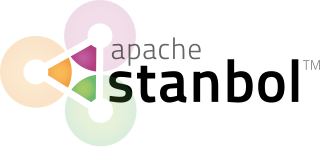REST is a software architectural style that was created to guide the design and development of the architecture for the World Wide Web. REST defines a set of constraints for how the architecture of an Internet-scale distributed hypermedia system, such as the Web, should behave. The REST architectural style emphasises the scalability of interactions between components, uniform interfaces, independent deployment of components, and the creation of a layered architecture to facilitate caching of components to reduce user-perceived latency, enforce security, and encapsulate legacy systems.
A web framework (WF) or web application framework (WAF) is a software framework that is designed to support the development of web applications including web services, web resources, and web APIs. Web frameworks provide a standard way to build and deploy web applications on the World Wide Web. Web frameworks aim to automate the overhead associated with common activities performed in web development. For example, many web frameworks provide libraries for database access, templating frameworks, and session management, and they often promote code reuse. Although they often target development of dynamic web sites, they are also applicable to static websites.
BD-J, or Blu-ray Disc Java, is a specification supporting Java ME Xlets for advanced content on Blu-ray Disc and the Packaged Media profile of Globally Executable MHP (GEM).
Domain-driven design (DDD) is a major software design approach, focusing on modeling software to match a domain according to input from that domain's experts.
Google App Engine is a cloud computing platform as a service for developing and hosting web applications in Google-managed data centers. Applications are sandboxed and run across multiple servers. App Engine offers automatic scaling for web applications—as the number of requests increases for an application, App Engine automatically allocates more resources for the web application to handle the additional demand.
A single-page application (SPA) is a web application or website that interacts with the user by dynamically rewriting the current web page with new data from the web server, instead of the default method of a web browser loading entire new pages. The goal is faster transitions that make the website feel more like a native app.
Jakarta RESTful Web Services, is a Jakarta EE API specification that provides support in creating web services according to the Representational State Transfer (REST) architectural pattern. JAX-RS uses annotations, introduced in Java SE 5, to simplify the development and deployment of web service clients and endpoints.
ZK is an open-source Ajax Web application framework, written in Java, that enables creation of graphical user interfaces for Web applications with little required programming knowledge.

Vaadin is an open-source web application development platform for Java. Vaadin includes a set of Web Components, a Java web framework, and a set of tools that enable developers to implement modern web graphical user interfaces (GUI) using the Java programming language only, TypeScript only, or a combination of both.

Spring Roo is an open-source software tool that uses convention-over-configuration principles to provide rapid application development of Java-based enterprise software. The resulting applications use common Java technologies such as Spring Framework, Java Persistence API, Thymeleaf, Apache Maven and AspectJ. Spring Roo is a member of the Spring portfolio of projects.
In computing, Open Data Protocol (OData) is an open protocol that allows the creation and consumption of queryable and interoperable REST APIs in a standard way. Microsoft initiated OData in 2007. Versions 1.0, 2.0, and 3.0 are released under the Microsoft Open Specification Promise. Version 4.0 was standardized at OASIS, with a release in March 2014. In April 2015 OASIS submitted OData v4 and OData JSON Format v4 to ISO/IEC JTC 1 for approval as an international standard. In December 2016, ISO/IEC published OData 4.0 Core as ISO/IEC 20802-1:2016 and the OData JSON Format as ISO/IEC 20802-2:2016.
IBM WebSphere Service Registry and Repository (WSRR) is a service registry for use in a Service-oriented architecture.
Canigó is the name chosen for the Java EE framework of the Generalitat de Catalunya.

ColdBox is a free, open-source, conventions-based, modular web application framework intended for building enterprise applications with ColdFusion (CFML) using a Hierarchical MVC approach.

Apache Stanbol is an open source modular software stack and reusable set of components for semantic content management. Apache Stanbol components are meant to be accessed over RESTful interfaces to provide semantic services for content management. Thus, one application is to extend traditional content management systems with semantic services.

Ember.js is an open-source JavaScript web framework that utilizes a component-service pattern. It allows developers to create scalable single-page web applications by incorporating common idioms, best practices, and patterns from other single-page-app ecosystem patterns into the framework.

icCube is known for its embeddable data analytics and visualization software platform tailored specifically for B2B Software-as-a-Service (SaaS) applications, i.e. Embedded analytics.
The OpenAPI Specification, previously known as the Swagger Specification, is a specification for a machine-readable interface definition language for describing, producing, consuming and visualizing web services. Previously part of the Swagger framework, it became a separate project in 2016, overseen by the OpenAPI Initiative, an open-source collaboration project of the Linux Foundation.
Oracle TopLink is a mapping and persistence framework for Java developers. TopLink is produced by Oracle and is a part of Oracle's OracleAS, WebLogic, and OC4J servers. It is an object-persistence and object-transformation framework. TopLink provides development tools and run-time functionalities that ease the development process and help increase functionality. Persistent object-oriented data is stored in relational databases which helps build high-performance applications. Storing data in either XML or relational databases is made possible by transforming it from object-oriented data.





